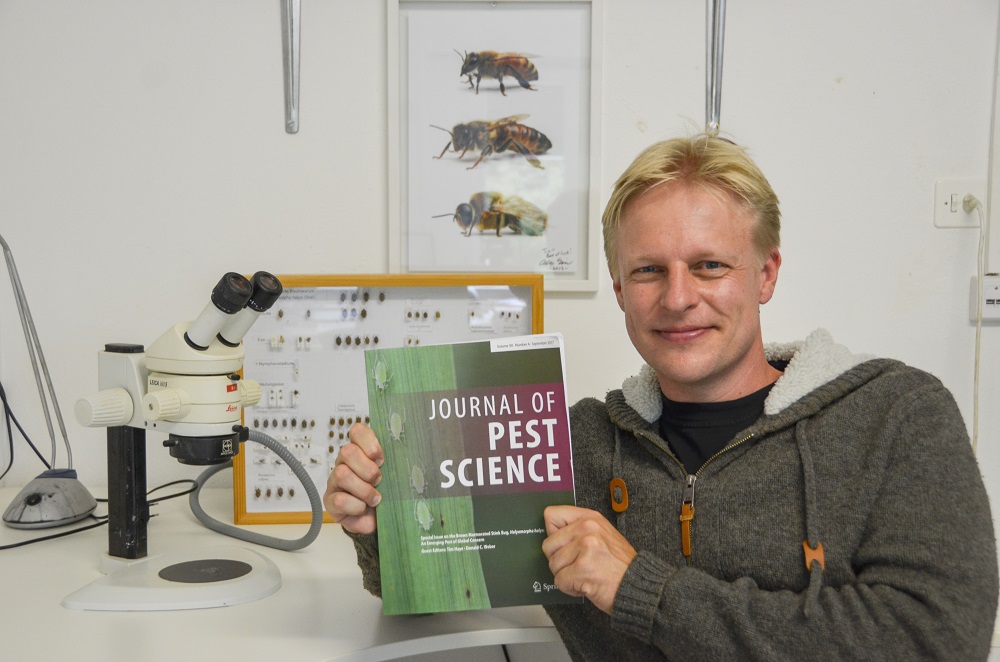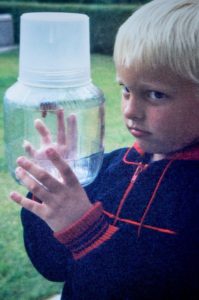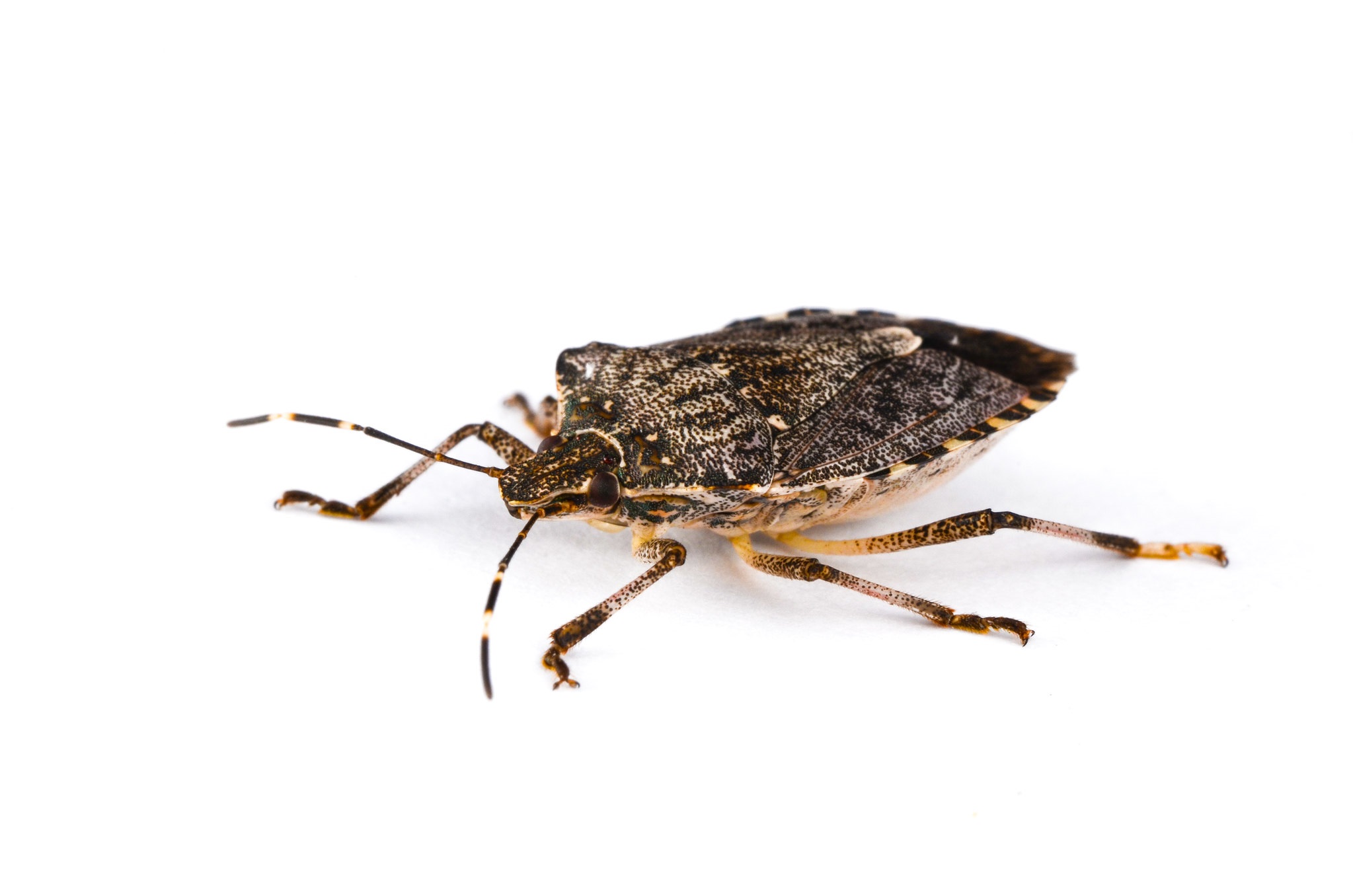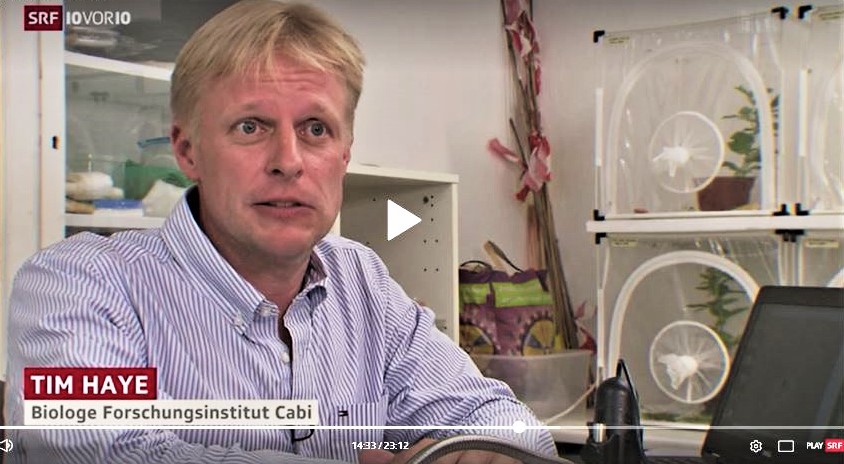
Tim Haye spends a lot of his time behind the lens of a microscope or camera studying and capturing a range of invasive pests – largely unseen to the human eye. Recently Tim has been the focus of attention himself with the Swiss media keen on learning more about one of his ‘bugbears’ – the destructive fruit and nut pest the brown marmorated stink bug (Halyomorpha halys).
Communications Manager Wayne Coles finds out more about the man behind the headlines….and his ‘beloved’ stink bugs!
What made you become a scientist and in particular the kind of scientist you are?
I already started as a kid, 5 years old, to collect insects in my parent’s garden. My parents did not motivate me or show me, it was just my natural interest, but I very much appreciated that my parents always supported my interest and let me rear all the insects in my room. I think curiosity was and is still my driving force.

Did you ever consider any other career and/or have you done any other kind of jobs?
Not really, for me it was always clear that I would become a biologist, but I was (and I still am) interested in many different areas of biology. I also studied marine biology and I have a passion for palaeontology.
What did your parents do as careers? Also, do you have any brothers or sisters and, if so, what do they do?
My mother was working in a bank and my father was a teacher at an elementary school. My sister is also a teacher. I guess that’s why also like to teach and work with students
Do you have any other interests/hobbies?
Palaeontology is my passion, I spend many hours searching for fossils in the Jura mountains and then spend hours carving them out of the rocks. The evolution of life I find one of the most fascinating topics in science. Otherwise, I also do a lot of photography, especially macro shots of insects.

How long have you worked at CABI and in what roles?
I started as a summer student back in 1998. I came back in 1999 to do my Masters with Marc Kenis in forestry on biocontrol of the lily leaf beetle. After I finished, I got offered a PhD position at the University of Kiel in Germany, and they basically let me decide what I would like to work on. I wanted to keep the CABI connection and contacted Dr Ulli Kuhlmann, who was leading the Agriculture Section at CABI Switzerland back then (the job I am doing now). They suggested to do my PhD on Lygus plant bugs. I agreed and spend 4 years at the University of Kiel in Germany. During these years I also spent several months at the Agriculture and AgriFood Canada centres in London and Ottawa in Ontario. During this time, I developed my interest in bugs in general. In 2004 I went back to CABI Switzerland and started my postdoc on cabbage seedpod weevil. In 2013 I took over the lead of the Agriculture section at CABI Switzerland.
When did you start researching the stink bug?
I started in 2012. At a meeting at our Swiss centre, our Canadian collaborator Gary Whitfield pointed out the importance of brown marmorated stink bug in North America and the high losses in fruit crops in the US due to the bug. We agreed to start a project on the bug and investigate its natural enemies in Asia for classical biological control. At the same time, I noticed that the bug was also reported from Switzerland back in 2008, but when I asked around, nobody seemed to be working on it in Europe. Seeing the high damage potential in North America, I started to have a closer look in Switzerland as well, assuming that we may end up in the same situation as the US. And indeed just 5 years later, high damage was reported from Europe as well.
What fascinates you about the stink bug? Why are you so fond of it?
I think stink bugs are a group that is very much underappreciated. There is a high diversity and if you start looking closer into the biology of the bugs, you find many fascinating aspects. For example, I love the variability of stink bug eggs. In addition, the natural enemies of stink bugs, mainly egg parasitoids, have a very unique behaviour that I love to study.

Is it really a pest or can it not be seen as a creature that can exist with some benefits and not something to control/destroy?
In most parts it is a major pest of fruit crops, especially where it has two generations. There are certainly no benefits to this species where it is invasive. We still know very little though how it interacts with the native fauna.
What are the major impacts of the stink bug?
It has a broad host range with over 300 plants that include various fruits, vegetables, row crops, and ornamentals. Both adults and nymphs feed on plant tissue by piercing and sucking especially on fruits and seeds, causing deformities, pitting, scars and discolorations that render products unmarketable. Outbreaks of Halyomorpha halys (HH) severely damaged orchards (pear, apple, peach, kiwi, hazelnut), greenhouse crops (peppers, cucumber and tomatoes) as well as other crops (maize, beans) in Italy (in 2019 estimated more than €100 Mill. damage, with up to 80-100% losses in the orchards), Hungary, Romania and Switzerland (crop losses up to 70% in greenhouses). The destructive potential of HH has also been demonstrated in Georgia (estimated USD 52-68 Mio losses in hazelnut production) and north-eastern US (USD 37 Mio losses in apple crops).
Does it really smell, why and what of?
It does! When the bugs feel threatened, the bugs release scented compounds as a defence against predators. In this case, the chemical compounds are aldehydes (Trans-2-octenal and trans-2-decenal).
What is the future for the stink bug in terms of its lifespan, distribution and impact? How is climate change affecting it?
Some bugs can live up to one year! The first occurrences in Europe were recorded in Switzerland (2004), followed by France, Greece, Eastern European countries. In Italy it was first officially detected in 2012. More recently, an impressive fast spread is being reported in Spain, Germany, France, Belgium, and the Netherlands. As of August 2019, HH is present with established populations in 28 countries on the European continent, including new regions such as countries on the Black Sea Region, Turkey and Kazakhstan.
In the southern Hemisphere it has been recorded in Chile since 2016, and intercepted many times in Australia and New Zealand. Its worldwide spread via movements of goods still continues. In the North its distribution is limited by the colder summer temperatures, but with increasing temperatures the distribution will shift northwards.
However, the major problem could be the increasing number of generations. In cooler climates the bug usually has one generation. In those areas the damage potential is relatively low as the bug populations can’t grow very fast. If spring and summer temperatures increase though, the bug will develop an additional generation and populations grow much faster. We have seen this last year in Switzerland. A very warm spring was followed by a warm summer and autumn. The egg laying of the bugs started nearly one month earlier than in ‘normal’ years. The bugs had enough time to develop a second generation in July/August, which then led to an outbreak scenario. With climate change we may have to get used to this scenario.
How concerned are food producers?
They are very concerned, especially in Italy where losses continue to be high. The stink bugs are not just threatening the livelihood of farmers, they are also affecting the food processing industry. For example, the stink bug recently arrived in Turkey, the biggest hazelnut producer worldwide. There are concerns that supplies of hazelnuts will decrease drastically due to stink bug’s love of hazelnuts, which then would affect companies like Ferrero, which depends on large quantities of nuts for their products, such as Nutella.
If it was ranked, where in the top 10 of crop pests would it come?
I don’t think it would be in the top 10 (yet). It depends on how you evaluate the importance. However, it does come in at number two on a list of ‘Top ten pests for research intensification’ – highlighting the importance of understanding this crop pest more.
What is the current research and future research on the pest?
I could write ten pages here…, I will only list a few things:
• Development of a forecast model to predict the occurrence of the bug and its damage potential based on the bugs phenology and climate data.
• Control methods, such as biological control, RNAi methods, ‘attract and kill’ methods.
• Development of an ‘electronic’ nose to detect stink bugs in shipments.
Additional information
Tim’s TV interview

See Dr Tim Haye talk about his research on the brown marmorated stink bug on Swiss TV SRF (in German).
Tim’s online media coverage (selected and in German, though articles can be translated using Google)
Achtung, die Stinkwanzen kommen! Warum dich das mehr betrifft, als dir lieb ist
Stinkwanze, Tigermücke und Co. – diese Tiere befallen auch die Schweiz
Der Schweiz droht erneut eine Stinkwanzen-Plage
Project page
Find out more about CABI’s work to find a biological control of the brown marmorated stink bug from the project page.
Tim’s pics
See the full array of stunning photos from Tim’s collection, including insects, animals, fossils, landscapes and more from Flickr.
